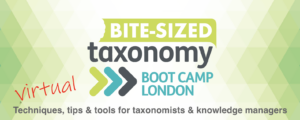By Siobhan King |
July 5, 2024
Practical applications of AI and taxonomies
It was great to catch up with so many of you all at last week’s Bitesize Taxonomy Boot Camp.
Bitesize Taxonomy Boot Camp is an event for taxonomy practitioners. Held quarterly online, it presents the ideal space to discuss techniques and tools and gain insights into case studies.
Metataxis Consultant, Siobhan King, joined numerous professionals from the fields of taxonomy, ontology and information architecture for June’s Bitesize Taxonomy Boot Camp, to hear from a great and varied line up of speakers discussing the challenges of developing taxonomies and incorporating AI.
Below are her key learnings:
“Will AI replace the need for taxonomists?” was a question at the back of some people’s minds during the Bitesize Taxonomy Boot Camp last week. Thankfully, the conclusion was: “Most certainly not.” Instead, AI needs to work together with taxonomists to ensure quality results.
Sarah Downs, Director of Client Solutions at Synaptica took us through the steps required for a good auto-categorisation project. The focus of this discussion was not on the technical tools involved, instead looking at the assignment of roles (including roles for machines), measures of quality, rule-writing approaches and “what good looks like” when selecting candidate taxonomies to support auto-categorisation. All very solid advice for someone approaching auto-categorisation for the first time, but also really validating for an experienced practitioner like me, to confirm that the methods we use at Metataxis are well ground in industry best practice.
“If you can’t find it, you can’t buy it.” Very wise words from Chantal Schweizer, Practice Director, Strategic Data Services at Pivotree. She shared practical guidance on developing taxonomies for e-commerce and revealed how a good taxonomy can improve the customer experience on ecommerce websites, with a demonstrable ROI through an increase of sales conversion rates, site traffic and the ability to cross sell products. Coming back her opening point about findability, Schweizer then emphasised the importance of clarity and specificity for e-commerce taxonomies. These were valuable lessons about the purpose of your taxonomy, particularly if you are new to e-commerce.

Tools can both help and sometimes hinder progress in managing taxonomies to meet the needs of your business. Tom Alexander, Taxonomy Manager at Cancer Research UK shared his learnings when his organisation moved from Drupal to a new CMS, called Contentful.
While perhaps Drupal could be classed as “adequate,” it is often reported to be clunky and not easy for taxonomists to work with. It typically tends to silo information, increasing the effort of taxonomists to ensure consistency and make connections. It is still early days for the charity, but the adoption of Contentful looks to improve the management of taxonomies, provide better insights and tailor every customer’s website experience in the future.
Jonathan Engel, Information Architect from InfoArk, demonstrated how easy it is for AI to “hallucinate information” with an entertaining question about a play performed at the New Theatre in 1971. In response to this query, ChatGPT presented a highly plausible sounding answer which stated 17 facts, of which 13 were incorrect. The point of this is that AI can “hallucinate” because it makes incorrect assumptions about relationships. This means two things:
- AI can be improved by IA (Information Architecture) which more accurately models relationships.
- AI can be used to support the building of taxonomies, but those uses are more strongly related to extending taxonomies by suggesting synonyms and relationships, and testing taxonomies by using rules. Human input is still needed to build the initial taxonomy, validate suggested extensions and govern taxonomies.
This was an interesting session that critically assessed the uses and limitations of AI for taxonomies.
Finally, Jo Kent, Research Fellow from the Science Museum Group de-mystified Agile projects for taxonomists. She provided a very helpful explanation of what an Agile project looks like and what it’s like to work in an Agile project for a taxonomist. Where traditionally taxonomists may have been involved in only one phase of a project and worked in isolation, with the Agile method, taxonomists are involved from beginning to end and are part of wider team. Each part of a taxonomy is developed in sprints, which Kent explained might feel piecemeal, but more often better fits the needs of the organisation because of the more integrated approach.
Each one of these presentations was very engaging and often entertaining. It was just as well we were given short breaks between sessions as each was very informative, full of practical advice and knowledge, giving attendees much food for thought. Key points to reflect on for me were:
- Transparency and explainability are critical when developing a tool that automates content categorisation, or uses any rules to categorise content. It is essential to understand how a machine has come up with its results to improve the development of rules and search prompts
- Understanding the needs of your users and the purpose of your taxonomy is vital to ensure you add value.
- AI should neither be uncritically embraced as a panacea for all woes or feared as the machine that’s going to put you out of a job. There will still need to be a human element in the development of taxonomies.
Join the next Taxonomy Boot Camp
I would highly recommend the Taxonomy Boot Camp to anyone working with taxonomies and information architecture. For me personally, this event presented lots for me to think about, but it was also really confirmative to hear that many of things we’ve been saying regarding the practical applications of AI here internally at Metataxis, are echoed throughout the professional community.



